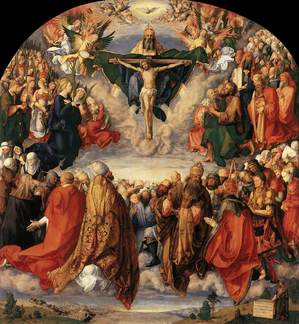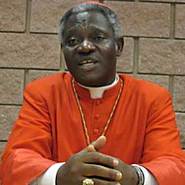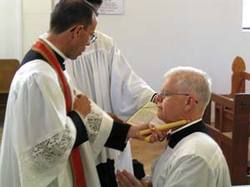 The Church celebrates her belief in the Most Holy Trinity, a communion of persons of Love. This feast given to us not to celebrate the revelation of an idea and divine works in history, but to meet in a personal way the community of the Trinity.
The Church celebrates her belief in the Most Holy Trinity, a communion of persons of Love. This feast given to us not to celebrate the revelation of an idea and divine works in history, but to meet in a personal way the community of the Trinity.
Tag: liturgy
“The Western Mass” — now really…..
Clearly the liturgical formation of seminarians in the Archdiocese of Vienna is pretty bad if what is protrayed here is true. Gloria.TV exposes yet another example of how some trash the sacred Liturgy under the guise of making it accessible to the people: “The Western Mass.”
Rome’s Pontifical Liturgical Institute celebrates 50 years, Pope marks event
 This week the Pontifical Liturgical Institute centered
This week the Pontifical Liturgical Institute centered
at the Pontifical Athenaeum of Saint Anselm (AKA Sant’Anselmo) held the Ninth International
Congress on the Liturgy in honor of the fiftieth anniversary of Institute’s
foundation. The theme of the congress was “The Pontifical Liturgical Institute:
Between Memory and Prophecy.” In the Clementine Hall, the Pope met with Abbot Notker Wolf, Abbot Primate and Chancellor of the Pontifical Athenaeum, Dom Juan Javier Flores, professors and participants in the Congress. The Italian version of the Pope’s talk is here; he English translation: Benedict XVI to Pontifical Liturgical Institute May 6 2011.pdf The Pope said several noteworthy things, among them:
the liturgical movement that sought to give new impetus and a new spirit to the
Church’s prayer, shortly before Vatican Council II and during its celebration,
asked the faculty of Benedictines on the Aventine Hill to establish a center
for study and research to ensure a solid basis for conciliar liturgical
reform,” said Pope Benedict XVI.
Continue reading Rome’s Pontifical Liturgical Institute celebrates 50 years, Pope marks event
Divine Mercy: Jesus bending over our humanity
 What will the years ahead bring us? What will man’s
What will the years ahead bring us? What will man’s
future on earth be like? We are not given to know. However, it is certain that
in addition to new progress there will unfortunately be no lack of painful
experiences. But the light of divine mercy, which the Lord in a way wished to
return to the world through Sr Faustina’s charism, will illumine the way for
the men and women of the third millennium.
today too humanity must welcome into the upper room of history the risen
Christ, who shows the wounds of his Crucifixion and repeats: Peace be
with you! Humanity must let itself be touched and pervaded by the Spirit given
to it by the risen Christ. It is the Spirit who heals the wounds of the heart,
pulls down the barriers that separate us from God and divide us from one
another, and at the same time, restores the joy of the Father’s love and of
fraternal unity.
Continue reading Divine Mercy: Jesus bending over our humanity
Acquiring the Mind of the Church
 Père [Cardinal] Yves Congar, OP, in 1963 quoted by Geoffrey Hull in The Banished Heart (2010):
Père [Cardinal] Yves Congar, OP, in 1963 quoted by Geoffrey Hull in The Banished Heart (2010):
totality than the liturgy. The Bible is certainly a marvelous teacher of
prayer, of the sense of God and of the adult convictions of conscience. Used
alone, the Bible might produce a Christian of the Puritan tradition, an
individualist and even a visionary. The liturgy, however, is the
“authentic method instituted by the Church to unite souls to Jesus”
(Dom Maurice Festugière). The sort of Christian produced by an enlightened and
docile participation in the liturgy is a man of peace and unified in every
fibre of his human nature by the secret and powerful penetration of faith and
love in his life, throughout a period of prayer and worship, during which he
learned, at his mothers knee and without effort, the Church’s language: her
language of faith, love, hope, and fidelity. There is no better way of
acquiring “the mind of the Church” in the widest and most interior
interpretation of this expression.
What is Septuagesima Sunday?
If you don’t pray the 1962 Missal at today’s Mass you would have missed the liturgical observance of Septuagesima Sunday. Those who prayed the Missal of Pope Paul VI heard the gospel of “an for an eye.” But what is Septuagesima Sunday and what would it mean to us today as Lent approaches? How does it relate to the overall liturgical life of the Church? There are several parts of the sacred Liturgy that face a startling change. There is a certain beauty and richness in the older liturgical tradition that seems to have been lost in the post Vatican II revisions…but that’s a theme for another time.
The famous Benedictine monk and writer of the 19th century, Dom Prosper Gueranger, gives perspective on the Season of Septuagesima:
separates us from the great feast of Easter.
the season of Septuagesima into her calendar. Let us now meditate on the doctrine hidden under the symbols of her liturgy. And first, let us listen to St. Augustine, who thus gives is the clue to the whole of our season’s mysteries.
‘There are two times,’ says the holy Doctor: ‘one which is now, and is spent in the temptations and tribulations of this life; the other which shall by then, and shall be spent in eternal security and joy. In figure of these, we celebrate two periods: the time before Easter, and the time after Easter. That which is before Easter signifies the sorrow of this present life; that which is after Easter, the blessedness of our future state… Hence it is that we spend the first in fasting and prayer; and in the second we give up our fasting, and give ourselves to praise.’
us, and having been buried together with Him, we shall rise again with Him to a new life.
Reception of Holy Communion –a pastor’s lead
Prayer, Doctrine, Life and Evangelization: are we coherent?
In weekly classes on the Catholic I’ve been stressing a few (of many) points:
- lex orandi, lex credendi, lex vivendi (prayer, doctrine, life): all have to cohere
- the Incarnation is a fact: in faith we encounter this fact, this Person, experience the exceptionality and the wonder
- the contemporaneousness of Jesus Christ
- the witness of the Catholic faith is true and it is true for all people
Saint Blase and the Blessing of Throats
Lord, hear the prayers of Your martyr Blase. Give us the joy of Your peace in this life and help us to gain the happiness that will never end.
The Church has few exact details of the life of Saint Blase (also Blaise, Biago, Sveti Vlaho) but we have the experience of his popularity through the centuries in the churches of the East and West. What we know is that Blase was a physician, the Bishop of Sebaste, Armenia and martyr. The Roman Martyrology tells us that he was beheaded in 316.
More info on Saint Blase is found here and here.
The Blessing of Candles on the feast of St Blase can be found here.
The Blessing of Bread, Wine, Water and Fruit for the feast.
From the Golden Legend again:
And when this good widow, which by S. Blase had recovered her swine, heard thereof, she slew it, and the head and the feet with a little bread and a candle, she brought to S. Blase, and he thanked God and ate thereof, and he said to her that every year she should offer in his church a candle, and know thou that to thee and to all them that so shall do shall well happen to them, and so she did all her life, and she had much great prosperity.
Even after imprisonment, he refused to worship the prince’s gods, and for punishment his flesh torn by wool combs. He was finally beheaded, martyred along with seven women and two children.
Today, due to the cure of the boy’s throat when the boy was choking, Saint Blase is patron against diseases or any other trouble of the throat.
The priest will bless two candles in honor of Saint Blase.
Don’t rush the praying of the Liturgy
 How does one form a deacon, priest and bishop to celebrate the ars celebrandi of the sacred Liturgy? Being side-by-side these sacred ministers I am often scandalized by the lack of composure and gravitas in the praying of the Mass and other liturgical rites. Several priests and bishops I know are such poor celebrants of the Mass that I would argue that Mass celebrated so poorly does in fact lead others away from the Church’s worship. And let’s not even speak of the many deacons who have no clue and poor presence in the sanctuary! Two cardinals I’ve seen celebrate the Mass in their cathedrals have the habit of running down the isle and up the stairs into the sanctuary with evident exterior indication of what is about to happen. Another needs a seat belt in the cathedra. Is it too much to ask for beautiful gesture, beautiful music, beautiful words, beautiful art and architecture in the sacred Liturgy? Beauty and prayer also warms interpersonal relations!
How does one form a deacon, priest and bishop to celebrate the ars celebrandi of the sacred Liturgy? Being side-by-side these sacred ministers I am often scandalized by the lack of composure and gravitas in the praying of the Mass and other liturgical rites. Several priests and bishops I know are such poor celebrants of the Mass that I would argue that Mass celebrated so poorly does in fact lead others away from the Church’s worship. And let’s not even speak of the many deacons who have no clue and poor presence in the sanctuary! Two cardinals I’ve seen celebrate the Mass in their cathedrals have the habit of running down the isle and up the stairs into the sanctuary with evident exterior indication of what is about to happen. Another needs a seat belt in the cathedra. Is it too much to ask for beautiful gesture, beautiful music, beautiful words, beautiful art and architecture in the sacred Liturgy? Beauty and prayer also warms interpersonal relations!
is absurd to hurry: this shows a lack of understanding and respect and may be
an occasion of scandal” (Byzantine Daily Worship, Alleluia Press: 1969).




